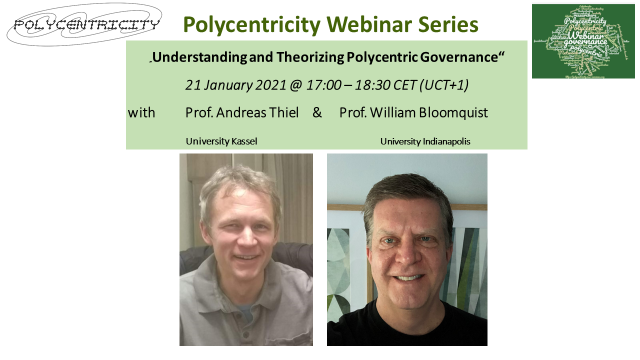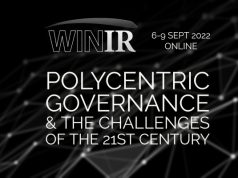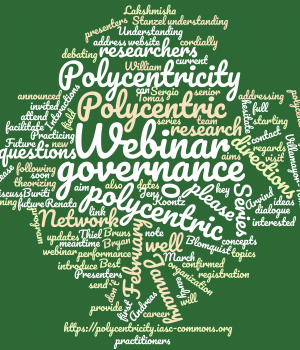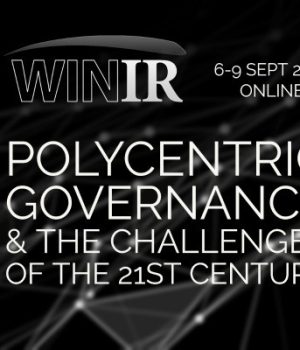In this post, Prof. Andreas Thiel and Prof. William Blomquist address further questions from the Q&A section of Webinar Session 1 from the Webinar Series on Polycentric Governance.
Questions and answers are roughly grouped by themes such as concept, method, practice; centres of decision-making; power and politics; change and adaptability; rules; effects and performance of PG; information; policy analysis and design; public-private partnerships; COVID-19; fields of research; the role of the researcher.
Note from the authors:
Thanks a lot for all the questions; Polycentric Governance (PG) is interpreted very differently by different scholars. Our interpretation is set out in Thiel, Blomquist, and Garrick, 2019 Governing Complexity. Cambridge: Cambridge University Press. Still, even authors of that book would interpret questions differently, for sure. Below you find Bill and Andreas’ interpretations.
PG: concept, method, practice
Q: How can a theoretical framework of polycentricity be brought to practice?
AT – R: Polycentricity for me is foremost an analytical framework for understanding self-organization among public, private, and civil society actors at higher scales and its performance. Wondering about the potentials of self-organization at such higher levels, it advocates the promotion of self-organization among semi-autonomous actors. Underlying conditions are laid out in several publications, also including our book. To bring PG into practice would require promoting PG. However, PG is probably not suitable for any collective action problem. It may be detrimental also for addressing some problems.
WB – R: See especially the chapter in our book by Bryan Bruns. Also, it may be useful to keep in mind that polycentric governance theory developed out of the observation of practice. The Ostroms and other scholars were attempting to formulate a way of explaining the way governance actually seems to have evolved and operated in actual situations. It was meant to be an alternative to public administration theorizing that did not seem to have any connection to observable practices and patterns in the world.
Q: Applying a polycentric “lens” seems to focus on the concept of polycentricity as a method for analysis. I also see other studies where polycentric governance is framed as a goal. Can you elaborate on the difference between using the concept of polycentricity as either a method or a goal?
AT- R: PG as a goal advocates the promotion of self-organization among autonomous actors. The lens looks at dimensions that are relevant to normative PG (PG as a goal) but it does not advocate self-organization. The difference lies in the analytical interest in the lens and normative advocacy of PG on the other.
Q: If PG should be used as a lens, can we still speak of “crafting” successful polycentric governance structures as Andreas Thiel suggested?
WB – R: I have a harder time thinking about polycentric governance as a goal. To my way of thinking, nearly all governance that exists in the world is polycentric, and recognizing that (i.e., looking at things through a polycentric lens) simply allows us to understand those situations better. Better understanding is also essential to making smart improvements to a governance situation, but in my view, “good governance” is a goal and polycentric governance is a fact.
Q: For researchers looking at a complex area, why should they choose polycentric governance as a tool for analysis, rather than other similar tools?
AT – R: If they were interested in self-organization dynamics in these systems and understanding them from an institutionalist perspective, PG offers a useful framework to analyze these and frame them normatively. I do not know other frames that explicitly aim to connect analysis with such a normative perspective.
WB – R: If another analytical tool helps a researcher understand a complex situation, there is clearly no problem with using that tool instead. For reasons that we cover in the Introduction and Section 1 (Chapters 1-4) of our book, polycentricity is a useful analytical lens that draws attention to the functions of and relationships among centers, and how changes to centers and their relationships may come about.
Q: What boundary conditions are others applying to both normative and diagnostic analysis of polycentric arrangements?
AT – R: I found it useful to think about the information actors (need to) share as a starting point for delineation.
WB – R: I think that’s really interesting too and cannot speak with any particularly authoritative perspective on the criteria that others use for making those distinctions.
Q: I look forward to finding out about methods to help answering all these different questions (see questions below) – I suppose that comes later?
AT: Any method that helps to understand PG is useful. Given the complexity of PG, qualitative research will most likely play important roles.
WB – R: I agree.
Centres of decision-making
Q: How can we define a “governance centre” and determine its boundaries vis-a-vis other centers? Who or what is in the centers? Are these networks of actors?
AT – R: I suppose a governance centre is something we recognize when we see it. For PG to function it is defined by its relative autonomy. Such boundary questions are always difficult to conclude on but empirically they can be resolved.
WB – R: To me, a center can be anything that isn’t an individual. A club, an association, a company, government, agencies within a government, etc., etc.
Q: How do “governance centres” relate to/differ from heterarchy (i.e. a network of hierarchies)?
WB – R: A network of hierarchies would easily be a polycentric situation. A heterarchy, therefore, is a type of polycentric situation but not all polycentric situations would be heterarchies. Polycentricity is therefore a broader concept that would encompass the concept of heterarchy.
Q: Are multiple centres of authority or decision-making in a polycentric system represented by the component, action situation, in the IAD framework? Or do centres just mean actors or collective entities or units of governance? This clarification is pertinent when we analyze the interactions among centres. If we consider action situations as centres in a polycentric system, then (in my understanding), does it make other constituents of the framework, such as patterns of interaction among centres/action situations implementable?
AT – R: Centres of decision-making may themselves be action situations, I agree. If we conceptualize a decision/position as an action situation or as a decision centre depends on the level of analysis I would think. These are decisions of the analysis. Patterns of interaction emerge as outcome of what we conceptualize as action situations, at what level these are situated is not set in stone.
WB – R: I agree. The IAD framework allows for the existence of “nested action situations.” A center composed of multiple individuals who interact and make decisions etc. may be analyzed as an action situation and may also be embedded in a larger action situation where that center interacts with other centers.
Q: What do you mean by entry and exit in polycentric governance? Is it for non-state actors?
AT – R: Entry means becoming part of self-organization dynamics on PG while exit means exiting from these dynamics. Entry supposedly means further legitimizing self-organization and supporting it; exit means delegitimizing it and weakening it. Ultimately, exit can undermine self-organization dynamics of a certain kind and purpose. That way, corresponding self-organization was contested.
WB – R: I agree, and would add only that the concepts of entry and exit may be understood as meaning nothing more than this: if there is a situation where multiple centers are present, then there presumably is some manner in which they got there (entry) and probably some manner in which they can disappear (exit). Polycentric situations will differ from one another in how easy or arduous it is to create a new center or dismantle an existing one. This is an important and useful way of analyzing differences between one polycentric situation and another.
Q: Do you have any examples for something which is not polycentric?
AT – R: Wherever self-organization does not play much of a role. The defense sector? Segments of emergency relief action?
WB – R: I find it very hard to think of actual situations in the world that are not at least minimally polycentric. Truly monocentric situations are rare, and yet we can find ourselves seeing or reading or hearing people who operate from the presumption that there is some single decision-making authority, some single center of power somewhere, that can just (figuratively speaking) flip a switch or issue a decree. To me, one of the most important advantages of “thinking polycentrically” is that it helps us understand the actual world because the actual world is polycentric.
Q: Would it be possible that these multiple centres of governance, which are interacting in a polycentric fashion, themselves are embedded in a hierarchical system with an authoritative body at the top?
AT – R: Definitely. The question would be if these lower-level centres act to some extent de facto as if independent or not.
WB – R: I agree.
Power and politics
Q: While no structure within the PG arrangement exerts full authority over the other, does that hold true for even the power that they exercise? As there may be systems with multiple interacting semi-autonomous bodies, but where discursive power or power by design may be concentrated unevenly across these systems. Would such systems also be considered polycentric?
AT – R: Where de facto great power asymmetries exist we cannot talk about PG in my view. PG is not focusing on the role of discursive power but recent extensions also of the IAD framework bring in such constructivist categories.
WB – R: I think power is always concentrated unevenly, whether in polycentric or monocentric governance structures. This includes discursive power, in my view. The question then becomes, in situations characterized by uneven power, how can those with less power ever hope to gain some improvement in their situation? One often missed characteristic of polycentric governance (in my view) is that when people are, to whatever limited degree, able to create or work within or change diverse structures, there are better prospects – or at least some prospects – of making change. When I think about power imbalances in monocentric hierarchies, I am unable to see how that power imbalance ever changes. Power imbalances, and sometimes really radical ones, will be present in all monocentric and polycentric governance situations. The difference, to me, is that I can at least imagine some hope of change in the latter and I cannot in the former.
Q: Question for Bill – Given that the organization of society usually leads to hierarchy, which can be characterized by authority, if polycentric governance recognizes no ultimate authority then how that condition can come about?
WB – R: My starting point would be to disagree with the premise that the organization of society usually leads to hierarchy. With all due respect to Michels and other theorists, I think no such generalization is supportable. If one wants to hypothesize that social organization leads toward hierarchy, one could find many supporting examples, and conversely if one wants to hypothesize that social organization tends toward entropy (things fall apart), one could find many supporting examples for that proposition as well. Now, setting that point aside and responding to your question more directly, I would try to clarify what we mean by an ultimate authority. The idea of no ultimate authority in a polycentric situation is actually an inference that follows from the definition that centers in a polycentric situation have some autonomy. That doesn’t mean the absence of power or hierarchy anywhere. It means that we would not characterize a situation as polycentric if (N-1) of the centers were merely the creations of the 1, which could abolish or reconstitute them at any time on its own. A unitary system, in which all but one of the components are at the mercy of that remaining one for their existence and functions, is not polycentric.
Q: Is polycentric governance heavily dependent on politics?
AT – R: I would agree that politics are part and parcel of PG. In this original formulation of the framework it is referred to as voice; i.e. agents raising the concerns about PG within the political system. PG marries the analysis of economic and political modes of contesting the way our needs are met by the collective we live in. I find this productive and enriching.
WB – R: Absolutely. When people create centers of decision-making, decide what those centers can and cannot do, how one center may or must or must not relate to other centers, and so on, those people are engaged in politics.
Change and adaptability
Q: Since different dimensions of polycentricity don’t appear to be static over time, what happens to the polycentric system as these dimensions change? Further, does the absence of one or two of the dimensions mean that a system may not be polycentric?
AT – R: I would think that dimensions change but cannot really be absent. If on the whole, a system can still be considered to be displaying important dynamics of self-organization depends on what we observe. In any case, for certain issues more monocentric governance may lead to better outcomes.
WB – R: The eight dimensions covered by Stephan et al. in our book and summarized on one of my slides are arrayed in a kind of order, starting with minimal conditions. (The first dimension being multiple centers. If there aren’t multiple centers, the structure cannot be polycentric.) Polycentric situations with all eight dimensions would be what Stephan et al call polycentric systems. Therefore, the absence of one or two dimensions does not mean that a situation isn’t polycentric. Your first question is also intriguing. Those dimensions are not static – relationships between centers (how they take each other into account) can change over time, presumably, the overarching set of rules could change, and so on. Thus by using the eight dimensions, we can some analytical leverage for characterizing not only how one polycentric situation differs from another but also how a polycentric situation is different at one point in time from how it is at another point in time.
Q: I’m interested in the interactions between polycentricity and adaptation. Would you consider adaptability a feature of polycentric governance, an outcome, both? And how would you study the impact of being a part of polycentric governance on the adaptability of a particular decision center?
AT – R: Very good question. Yes, it is proposed that PG is adapting well. However, in my view this should be researched more in detail and for diverse and also extreme situations. What system-level adaptation means for individual centers is not the focus of PG. However, given that PG offers the tools for micro-analysis of actors’ interactions, this could be addressed. Most likely system-level adaptation leads to winners and losers among decision centers.
WB – R: I view adaptability as a performance criterion. We can look at any structure – polycentric or not – and ask whether it shows evidence of being adaptive and to what extent. In my view, there are reasons to believe that polycentric structures are more likely to be adaptive. For instance, compared with a monocentric hierarchy, a polycentric structure is more likely to generate information and feedback at multiple levels and to create opportunities for differences of interpretation and differential impacts of phenomena to be articulated (which sometimes happens through conflict). I’m sure that polycentric structures and monocentric ones can both get “stuck” and fail to adapt well, but I also think there are good reasons to believe that monocentric structures are more susceptible to it than polycentric ones.
Rules
Q: How do the PG dimensions of „overarching set of rules“and „relations and order are emergent“ relate? They seem to be somewhat contradictory.
AT – R: PG in the end operates in practice at what is also called the operational level of institutional analysis (i.e. day to day practices); the idea is that PG practice is couched in modes of decision-making and interaction, and positionings of actors (both at collective choice, constitutional and meta-constitutional levels) that facilitate self-organization at the operational level; the exact form of day-to-day PG can vary in relation to types of problems.
WB – R: I agree – nothing to add to that.
Q: Expanding upon the enabling condition for PC of “overarching set of rules” to “generally applicable rules and norms structure actions and behaviors in the system” (Carlisle & Gruby, 2019), how what, or who defines these rules? And how or what determines whether rules remain relevant and applicable over time as the system adapts in response to different collective action challenges? What if the norms and rules favor more powerful actors over others, for example advancing the governance objectives of certain actors more than others (e.g. environmental objectives, poverty alleviation objectives, etc.)? Rules and norms that apply to some actors (to advance their aims, values, and objectives in governance) may contradict with or exclude the aims, values, and objectives of other actors, especially with inherent structural power imbalances.
AT – R. Very perceptive question. I agree that PG also creates outsiders. Members or constituents of PG, therefore, exclude others. I would agree that this can become detrimental to such populations. It would need to be catered to the opportunities and abilities of actors that are excluded to self-organize themselves. Such dynamics would potentially also innovate existing PG over time and in evolutionary manners. Structural imbalances would therefore need to be mediated; this would be a task of constitutional or overarching rules in my view. What you allude is very rarely addressed by students of PG.
WB – R: I agree. There is nothing about polycentric governance in my view that implies equality of power and access. A situation can be polycentric and yet in that situation, it is easier for some to organize and act than others, easier for some to mobilize and deploy resources than others, and easier for some to achieve favorable outcomes than others. To identify a situation as polycentric is not the same thing as identifying that situation as “good” with reference to any evaluative criterion (fairness, efficiency, adaptiveness, etc.) That is a separate stage of analysis.
Effects and performance of PG
Q: In order to answer any questions about effects, do we need to previously have answered all other question areas?
AT – R: Good question. I suspect in one way or the other all issues need to be addressed, but with different levels of depth. Few effects could still be the focus.
WB – R: I agree. The sets of questions presented in chapter 2 of our book for identifying and characterizing a polycentric situation are not arranged in a rigid order, but I do think it would be difficult to get useful and defensible answers to questions about effects until one has at least characterized the situation to some extent by asking the other sets of questions.
Q: There is heterogeneity of actors in the diagram in the normative perspective- where and how can inequality among actors fit here?
AT – R: I would expect that to be one of the core elements of heterogeneity. I suppose you mean economic inequality. It may lead to diverse concerns of actors regarding collective goods provision, which require different modes of organization. Above a question was raised about abilities of self-organization; these may be compromised by inequity. Thus, the dangers of PG to reproduce inequity would need to be addressed. Fascinating pathway for further thinking and researching about PG.
WB – R: Exactly. There is no presumption that all centers, or the individuals operating within them, are on a level playing field.
Q: What approaches have been used to empirically assess or quantify different levels of performance of PG and identify their bottlenecks?
AT- R: Any kinds of performance criteria could be used. Resilience, adaptiveness, effectiveness, attainment of certain policy goals, and sometimes equity are the criteria that are applied most often. Quantification is very complex in this regard. The next Colloquium (webinar session 2) will be addressing these questions more in detail.
WB – R: I agree.
Information
Q: How does the debate of bottom-up vs top-down governance fit in polycentric governance? Especially given the information and knowledge asymmetry?
AT – R: I would think that normative PG, i.e. those that advocate self-organization, promote bottom-up information. It depends on the issues at stake if this was the best way to address governance issues.
WB – R: I agree. To me, it is hard to imagine a governance situation being polycentric and also being entirely top-down, simply because centers having at least some degree of autonomy is such an important characteristic of polycentricity. But very few (if any) governance situations we encounter in the world are entirely bottom-up or entirely top-down, so we can look at polycentric governance situations and examine their bottom-up and top-down characteristics.
Q: Does polycentric government always resonate with complex adaptive governance if we consider knowledge and information asymmetry?
AT – R: Yes, very much so. It tries to provide a language and normative perspective for addressing these.
WB – R: Knowledge and information asymmetries would definitely complicate, and may impair, the functioning of a polycentric governance situation. The same would be true in a monocentric situation as well.
Policy analysis and design
Q: What are the roles of deliberative policy analysis in polycentric governance in action situations?
AT – R: PG focuses on the role of institutions in collective action. The question would be what deliberative policy analysis can add to this understanding looking at process qualities of PG.
WB – R: I agree, and it can also be useful to look at a polycentric governance situation from a deliberative policy analysis perspective and ask questions about whether and how deliberative policymaking occurs or doesn’t occur in that setting.
Q: How does the idea of polycentricity might help with policy design for so-called wicked problems, bearing in mind that many if not most sustainability problems are of this type (multiple, interconnecting processes with feedbacks and often social contestation, path dependencies, etc.)?
WB-R: Wicked problems really test our limits as human problem solvers. Because of the interconnections among the various components and dimensions of wicked problems, we like to imagine that if we could just unite everything into a single comprehensive decision-making process, that would allow us to better address wicked problems. Unfortunately, there is very little empirical evidence that people get better at solving problems as the problems grow in scale and complexity. People are capable problem solvers, but with pretty significant limitations. Of course, dividing and parceling out the components of wicked problems also fails to address their wickedness. So we are left with only suboptimal options. We can attempt comprehensive solution finding, hoping to somehow overcome our fallibilities and limitations. Or we can allow for specialized focus through diverse overlapping structures while also trying to construct institutional and organizational bridges and linkages between them whereby information can be shared, contestation can take place, and needed elements of coordination can be attempted. Both of these will be imperfect in handling wicked problems, so both analysts and practitioners have to decide which approach to try.
Public-private partnerships
Q: Can we call public-private partnerships as polycentric?
AT – R: Yes, we can expect to observe these in PG. Very good example. Also, co-production and -management are at the heart of PG.
WB – R: I agree.
COVID-19
Q: How might we apply the polycentricity lens to COVID-19? Particularly, say, the decision about whether to impose national versus local lockdowns?
AT – R: I am sure this would be very interesting and useful. Also, it needs to be captured what particular characteristics of the fight against the pandemic shape the performance and different approaches.
WB – R: I agree. In addition to Andreas’ point, I would add this: polycentric governance situations lend themselves to strategic “forum shopping” and “blame shifting” by individuals and organized interests. People who want more restrictive measures and perceive the national government to be more receptive to that will rationally contend in favor of national action. Or vice versa. Officials at the national level who can see that they have a political no-win situation on their hands may rationally content that decisions should be made at the local level. And so on.
Fields of research
Q: How can we theorize polycentric governance in regional climate change adaptation and mitigation issues?
AT – R: I would start characterizing such a constellation in a case-sensitive manner using the framework laid out in the book above.
WB – R: See also Elinor Ostrom’s 2010 article on a polycentric approach to climate change, and various publications by Daniel H. Cole since then.
Q: Does polycentric governance is meaningful in natural resources?
AT – R: I found it very useful to apply this lens to social-ecological systems governance for example, which, as such, shares many of the basic features of PG. If a particular constellation of SES governance also functions in a self-organizing manner and if this was beneficial for society would then be an empirical question.
WB – R: I agree. Many published analyses of polycentric governance situations have involved natural resources, precisely because natural resources frequently have multiple scales and interconnections and therefore the ways in which people deal with natural resources (well or poorly) are usually characterized by the creation of multiple organizations that relate to one another in various ways. Our book relies almost entirely on natural resource examples for illustrations.
Role of the researcher
Q: What is the role of the researcher? You mentioned normative, but could the researcher be active, in the sense of facilitating governance? And analyze it as well?Or is it about analyzing ongoing governance situations?
AT – R: Sure. The researcher could try to facilitate PG in the sense of promoting self-organization. This may build on thorough analysis. WB – R: The third installment in the webinar series (webinar session 3), by Bryan Bruns, will address the role of the researcher more directly.
WB – R: The third installment in the webinar series (webinar session 3), by Bryan Bruns, will address the role of the researcher more directly.














Thank you very much for the responses from AT and WB and to the team for systematically structuring the discussion which is of great value to improve our understanding!
Thank you for your comment, Srinivasa! Please feel free to use this comment section also to continue the discussion on any of the Q&As posted here. Further discussions among members are welcome!
Comments are closed.